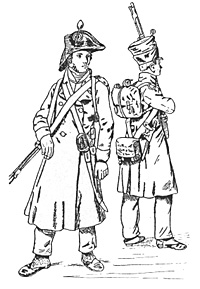 If you are reading this, you are either a solo gamer, or someone considering playing a solo game, or just plain curious as to what it is that solo gamers do. Iím writing this for all three types of readers to give them a personalized perspective of how one solo wargamer creates his battles.
If you are reading this, you are either a solo gamer, or someone considering playing a solo game, or just plain curious as to what it is that solo gamers do. Iím writing this for all three types of readers to give them a personalized perspective of how one solo wargamer creates his battles.
First comes inspiration. I read military history for a living and I see any ďwar movieĒ out there, to include some fantasy or science fiction films. Inspiration comes easily to me. Some scene or chapter just kindles a flame and I want to fight it out on my own. Iíve written before how the movies Saving Private Ryan, Gods and Generals, The Alamo, and The Lord of the Rings trilogy all were inspirational. Gates of Fire and any of the Lost Regiment series also infuse me with a desire to wargame the various scenarios. My problem, if it is a problem, is that there is too much inspiration out there. Life is too short to wargame everything you want to, so just get started and see how much you can do.
I usually apply a rule of thumb to see if I am serious about developing a new game. If I donít already have at least some appropriate figures, Iíll pass on a potential scenario Ė at least for the time being. I have figures to support much of the 19th century: Napoleonics, American Civil War, Texas Revolution, and War of 1812. Also, I have hundreds of WW I and II unpainted plastics for 20th century endeavors. Now, I have violated this rule once. The Lost Regiment series was just so thrilling to read that I created a Tugar army and several of its human enemies. Also, I draw on my sonsí armies to support any large-scale sci-fi or fantasy wargame as well.
I always use a new scenario as an excuse to buy and paint more figures. So, if I embark on a new undertaking, I spend some time raising a fresh regiment or two. For some reason, I really get a kick out of committing a new formation to a wargame battle for the first time. Also, while Iím painting the figures, Iím meditating on the scenario itself.
The type of operation drives the specifics of the scenario. Is this going to be a meeting encounter? A siege? A set-piece slug fest? An ambush? How about an amphibious assault or a forest battle? When this is answered, I need to decide what role Iím playing. There are really two choices. I can either command both sides or I command one side and ďautomateĒ the other side. [I just about always make this second choice.]
Usually the side with the fewest options is the side that is ďautomated.Ē More often than not, this is the defender. For example, if a siege, Iíll command the attackers. If an ambush or series of ambushes, again, Iím the force being ambushed. But know that you can successfully automate either attacker or defender. To explain some of the steps that follow, letís use the example of a meeting engagement.
Okay, Iíve decided to do a Napoleonic meeting engagement and Iím going to be the French moving deep into Russia in 1812. Now I need to set some parameters, some limits which further define the scenario. I look at how many figures I have. I usually wonít design a scenario with more than about 20% more figures than I can actually field. (That means that you recycle casualties). I figure Iíll use a division-sized advance guard versus an undetermined number of Russians. As I look at possible terrain, I decide that I want rolling terrain, perhaps 20% wooded, cut by some streams, and with few roads. I wargame on a 4 x 8 board. See the map for what I came up with. Note that I put in twenty check points which mirrors a D20. These are locations where some activity may take place.
Okay, I have two parameters so far Ė a game table and a rough count of the forces Iíll use. Now I need to decide what variables I want to use in my scenario to make it a challenge for me. What variables might I consider?
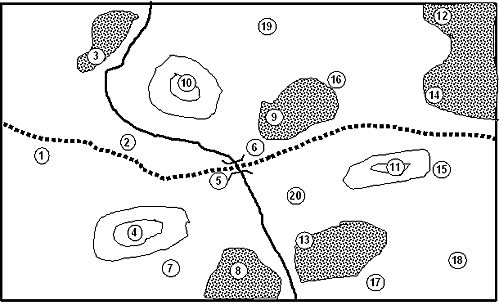 Terrain
Terrain
I could have made the terrain a variable. That is to say, I could easily have diced to see the layout of the ground I would march over. I could set up a chart with the type and number of terrain features and then dice again for the location. I chose not to do that for this scenario except that I will dice for fords. The French are moving eastward (left to right on the map). The French commander knows that there is a river crossed by a bridge. He does not know if there are any sites which can be forded. So, I could divide the river up into several segments - maybe 8 or so. Then, when a French unit comes up to the edge of the river, I can dice to see if there is a ford along that segment. Maybe a roll of 6 means Iíve discovered a ford that accommodates horses and infantry. I roll again and a roll of 4-6 means that artillery can cross as well. I can also roll at the bridge to see if it has been blown by the defenders. And if so, the French can ONLY cross at a ford. Anyway, figure out what you want to do beforehand and scratch down some tables or odds.
French Forces
I can dice to determine the type and size (and even quality) of the French advance guard. The tables below give you an idea of how it could work.
- Cavalry
1 - 2 1 regiment dragoons
3 - 4 2 regiments chasseurs a cheval
5 - 6 1 regt. hussars, 1 regt. chasseurs
You can develop a chart like this for infantry and artillery as well. After building an order of battle, then roll for the quality of each regiment.
-
Quality
1 - 2 recruit
3 - 5 veteran
6 elite
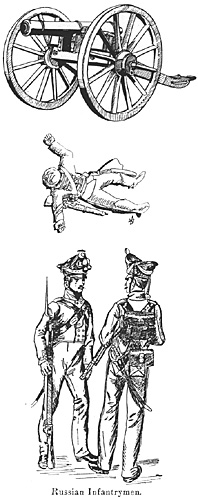 If you want, you can roll for the quality of the brigade commanders in your advance guard division, those who will carry out your brilliant orders.
If you want, you can roll for the quality of the brigade commanders in your advance guard division, those who will carry out your brilliant orders.
Order of March
Finally, the French need to determine an order of march. This is something I do for myself rather than roll for. I design an order of march with mounted troops on the flanks and front, perhaps augmented by light troops. The bulk of the infantry and artillery are road bound. Letís say I diced and the following order of battle was the result.
- 2 battalions legere
6 battalions line
2 squadrons hussars
2 squadrons chasseurs a cheval
2 horse batteries (6#)
My order of march might be:
- Advance: 2 squadrons chasseurs and 1 battery (with a brigade commander)
Main Body: line infantry and 1 battery (with a division and a brigade commander)
Right Flank: 1 squadron hussars & 1 battalion legere
Left Flank: 1 squadron hussars & 1 battalion legere
Rules
I personally use home-grown rules but use whatever you are comfortable with. Any rule set should address movement, morale, and resolve firing and melee which is pretty much all you need. If I use subordinate brigade commanders, then I need rules that address the probability that he does what I order him to do effectively and in a timely manner.
Now for them Russians
The biggest piece of this game is for the French commander (me) to come upon an undetermined number of Russian defenders at unknown locations. This is a four part process. Each turn I roll to determine if a unit of Russians appears. If yes, then I roll to determine the type and size of unit. Then, I roll to determine where the Russian unit shows up. Finally, I dice to see what the Russian unit will do. Here we go.
First, do Russians appear? At the start of every turn, roll a D6. A result of 6 means that Russians enter the game.
Second, roll D10 to determine unit type and size.
-
1 1 battalion jaegers
2 1 battalion jaegers
3 1 battalion line
4 1 battalion line
5 1 battalion line
6 1 battalion grenadiers
7 1 squadron hussars (or other light cavalry)
8 1 squadron hussars (or other light cavalry)
9 1 squadron dragoons
10 1 battery
Third, roll to determine location of this Russian unit. I have 20 checkpoints so I use a D20. Any other combination works well too. The rule is that the Russians canít show up at a checkpoint that the French have passed through. For example, let us say that the French main body has passed through checkpoints 1 and 2 and the left flank guard has passed through checkpoint 3. If I roll the D20 and get a 1, 2, or 3, I just roll again until I get a different solution.
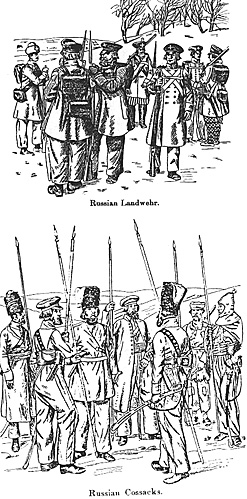 Please note the obvious. The more quickly the French can get across the board, the fewer chances that Russians will appear. Also, the more checkpoints the French pass through, the more likely that the Russians will appear in a limited number of spots.
Please note the obvious. The more quickly the French can get across the board, the fewer chances that Russians will appear. Also, the more checkpoints the French pass through, the more likely that the Russians will appear in a limited number of spots.
Now there is a problem that I have not been able to satisfactorily address. What if the Russians show up at a location that is not within line of sight of the French. For example, the French are still west of the river and the Russians turn up at checkpoint 15, out of the view of the French. What I do is to put the Russians down anyways. Perhaps a column of dust rose up as they were marching and the French noticed it. Perhaps a squad of French hussars infiltrated the Russian position and saw them and reported their presence. As it turns out, my being aware of Russians that your troops on the table canít see hasnít swayed my planning much.
There is a solution. Make the checkpoints a circle of card stock with the number on one side. If I had a partner (spouse, offspring etc.) I could have them throw the location die. Then, if in their judgment the French would not be able to see the checkpoint, then they would annotate the type of Russian unit and its orders on the bottom of the card stock checkpoint. When the French arrive at a location that could see the checkpoint, then turn over the marker and see whatís there. If the marker is in the woods, then donít turn it over until the French get within musket range. This allows the Russians to get the first shot from a concealed position.
The final roll is to determine the orders governing the Russian unit. There are only two options that seem likely. Either the Russian unit defends in place (most likely) or it attacks. A chart might look like this.
- 1 Defend in place
2 Defend in place
3 Defend in place
4 Defend in place
5 Attack nearest French unit on your side of river (if none, defend in place).
6 Move toward bridge, attacking any French unit en route.
This would apply only to infantry and cavalry; artillery batteries would always defend in place.
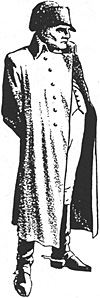 Victory Conditions
Victory Conditions
While the purpose of the wargame is to exercise the gray matter and to derive a thrill from an unpredictable situation, we might still want some indicator of success. The purpose of an advance guard is to make contact with the enemy, secure the main body from surprise attack, to fight through what it can, grab defensible terrain as possible, and to develop the situation within its power. It is not expected to fight to the death. As a minimum victory condition, the French advance guard has to secure the bridge and establish a bridgehead on the Russian side. This means having a defensive line that includes checkpoints 6, 9, and 11. A substantial victory would mean extending that defensive line to include hill 10 and the woods at 13. A complete victory would be passing off the table with at least one-third of the force intact.
So there you have it Ė some thoughts on how I put together a solo battle. My next project? Iím considering creating a scenario from the Battle of Shiloh in the American Civil War. A lot of the troops were raw and the commanders of decidedly mixed competence. Much of the battle will be in wooded terrain. Iím busy right now painting a regiment each of Yankees and Rebs. If all goes well, Iíll write up a battle report before too long.
Back to Table of Contents -- Lone Warrior # 150
Back to Lone Warrior List of Issues
Back to MagWeb Magazine List
© Copyright 2005 by Solo Wargamers Association.
This article appears in MagWeb.com (Magazine Web) on the Internet World Wide Web.
Other articles from military history and related magazines are available at http://www.magweb.com
